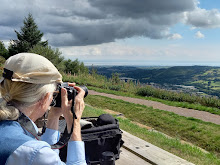I first put together a jig to achieve repeatably for the slender legs. Since 6 chairs are need for the set, 12 as near identical legs as is practical to achieve is a major goal.
The jig is first used to mark out with a draftsman's pencil one side of the legs profile on the mahogany, 3mm thick, before roughing the shape using the fret saw.
I came across this method of finishing a profile on Utube in a search for how to make the front legs, more of which later. Essentially, the pin is used as a guide to follow the profile required.
Using the jig,
the cut on the leg is guided by the profile. I found that there was a danger of the jig lifting as the tool sometimes snatches the wood, spoiling the work piece or worse, damaging the profile on the jig - hence the enclosed cutter. A damaged jig means making a fresh one!!! Also, a bit safer to use with less chance of catching your fingers. Ouch!!! Repeat the process for the other side of the leg.
Dada.......12 legs for 6 chairs.
Another jig was made to assist in machining the slots and holes on the inward facing surfaces of the legs, 6 being left hand and 6 right hand for the stretchers connecting the two legs.
The slots and hole were machined using a 1mm diameter mill.
To be perfectly honest, I was very skeptical about being able to turn wood down to a 1mm diameter, but here is the proof that it can be done.
The first trp joint.y at assembly. So far so good.
After fixing the legs length against the jig, use a file to form the 1 mm dia. peg for the chair to














No comments:
Post a Comment